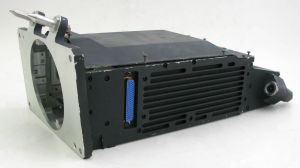Welcome to our Website
HUD Electronics Unit

| Catalogue Number | C0327 |
| Sub-categories | |
| Year of manufacture | Circa 1991 |
| Location | Rack RAA05 [Main Store] |
| Object Type | Signal/Data Processor |
| Division | Airborne Display [ADD] |
| Platform | |
| Manufacturer | |
| Part No | 51-069-01 |
| Serial No | 001 |
| Dimensions | Width (mm):190 Height (mm):190 Depth (mm):369 Weight (g):9760 |
| Inscription(s) | Electronics Unit 51-069-01 S/N 001 ──────────────── GEC Avionics Limited LVPSU Part No K0656SOCN7506-00098 Serial No 1940 Mfr Part No. K0656/4-298-01 NSN Contract No. F33657-84c-0192 ──────────────── GEC Avionics Limited Warranted Item This item is under warranty until 10 Jun 92 |
| Notes | This is the Electronics Unit from the Maryland HUD system flown in the Gulfstream II trials. It is fitted with a Nailsea LVPSU 7506-00098, Ser. No.1940 Contract F33657-84C-0192 (See Cat. No. C0331). The 1553 interface was replaced with an ARINC 429. The Electronics Unit later went on to be fitted to a BAC 1-11 research aircraft by Westinghouse in Baltimore to support their Boeing supported "ESAS" program in concert with Honeywell, and eventually led to the Honeywell connection with Marconi Avionics with the HUD 2020 system. |







